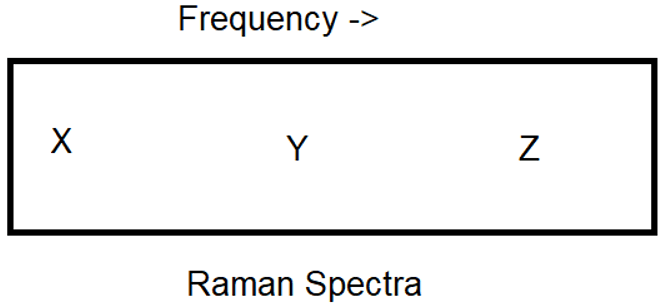This set of Engineering Physics Multiple Choice Questions & Answers (MCQs) focuses on “Raman Effect”.
1. Raman effect is scattering of ________
a) Atoms
b) Molecules
c) Protons
d) Photons
View Answer
Explanation: The inelastic scattering of a photon by a molecule that is raised to higher energy levels is called the Raman effect. It was discovered by C.V. Raman.
2. The elastic scattering of photons is called as ______
a) Atmospheric scattering
b) Rayleigh Scattering
c) Conserved Scattering
d) Raman Scattering
View Answer
Explanation: The elastic scattering by a material is called the Rayleigh Scattering. The inelastically scattered photons are called as Raman scattered photons.
3. Which of the following cannot be conserved during Raman scattering?
a) Total Energy
b) Momentum
c) Kinetic Energy
d) Electronic Energy
View Answer
Explanation: The Raman scattering is the inelastic scattering of a photon by a molecule. In inelastic scattering, the Kinetic energy is not conserved.
4. How many degrees of freedom does a chemical compound of N atoms have?
a) 2N
b) 2N + 1
c) 3N
d) 3N + 1
View Answer
Explanation: For any given chemical compound, there are a total of 3N degrees of freedom, where N is the number of atoms in the compound.
5. In Raman spectroscopy, the radiation lies in the ________
a) Microwave Region
b) Visible Region
c) UV Region
d) X-ray Region
View Answer
Explanation: The radiations used in the Raman spectroscopy lie in the visible region or the low infrared region. They are high intensity beams. He-Ne laser is used in Raman spectroscopy for the production of high intensity light.
6. The change in frequency is due to the transition between vibrational or rotational energy levels.
a) True
b) False
View Answer
Explanation: In Raman effect, 99 % of the light has the same frequency while less than 1% of the light’s frequency is changed due to the transition between vibrational or rotational energy levels.
7. The Raman spectrum is said to consist of Strokes lines when ________
a) Δv > 0
b) Δv < 0
c) Δv = 0
d) Does not depend on Δv
View Answer
Explanation: We know, Δv = vi – vs. Thus, when Δv > 0, the Raman effect is said to consist of Strokes lines and when it is negative Raman effect is said to consist of anti-strokes lines.
8. The Rama shift generally lies between ________
a) 100 – 1000 cm-1
b) 100 – 2000 cm-1
c) 100 – 3000 cm-1
d) 100 – 4000 cm-1
View Answer
Explanation: The Rama effect generally lies between the range 100 – 4000 cm-1, which falls in far and near infrared regions of the spectrum.
9. Raman lines are ________
a) Weak
b) Strong
c) Curved
d) Blurry
View Answer
Explanation: The lines observed in the Raman effect are generally weak. Thus, long exposures are required with conventional light source.
10. Which of the following stands for the Rayleigh scattering in the Raman spectra shown below?

a) X
b) Y
c) Z
d) None
View Answer
Explanation: In the shown spectra, X stands for the Strokes lines, Y stands for the Rayleigh scattering and Z stands for the anti-strokes lines.
11. The most commonly used laser for Raman spectroscopy is ___________
a) ND: YAG
b) Ruby laser
c) He-Ne laser
d) Semiconductor Laser
View Answer
Explanation: The most commonly used laser in Raman spectroscopy is He-Ne laser (632.8 nm). Lasers are used as they possess the advantages of providing high intensity of light collimated in a particular direction.
12. Which of the following lines are most intense?
a) Stokes lines
b) Rayleigh-scattered lines
c) Anti-strokes lines
d) All have same intensity
View Answer
Explanation: The Rayleigh-scattered radiations are considerably more intense than either of the other two types – Strokes lines and Anti-Strokes lines.
13. For a particular vibrational mode to appear in the Raman spectrum, what must change?
a) Frequency of radiation
b) Intensity of radiation
c) Molecule’s shape
d) Molecule’s polarizability
View Answer
Explanation: For a particular vibrational mode to appear in the Raman spectrum, the molecule’s polarizability must change during the course of the vibration.
14. Infrared and Raman spectra are complementary to each other.
a) True
b) False
View Answer
Explanation: The given statement is true because of their different selection rules for activity. A change in polarizability must occur for a vibration to be Raman-active, but for a vibration o be Infrared-active, there should be a change in dipole moment.
15. The Raman shift, related to force constant k and reduced mass μ, is given by ________
a) \(\frac{1}{2π}\sqrt{\frac{k}{μ}}\)
b) \(\frac{1}{2πc}\sqrt{\frac{k}{μ}}\)
c) \(\frac{1}{2π}\sqrt{\frac{μ}{k}}\)
d) \(\frac{1}{2πc}\sqrt{\frac{μ}{k}}\)
View Answer
Explanation: The correct expression for the Raman shift is: \(\frac{1}{2πc}\sqrt{\frac{k}{μ}}\). It is same as the expression for the shift in Infrared Spectroscopy. Thus, they are complementary to each other.
Sanfoundry Global Education & Learning Series – Engineering Physics.
To practice all areas of Engineering Physics, here is complete set of 1000+ Multiple Choice Questions and Answers.
If you find a mistake in question / option / answer, kindly take a screenshot and email to [email protected]
